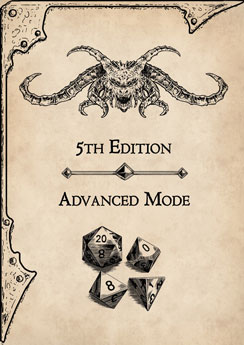Small beast (giant animal), unaligned
Armor Class 13 (Natural Armor)
Hit Points 4 (1d6+1)
Speed 30 ft., climb 30 ft.
Proficiency Bonus +2
Proficiency Bonus +2 (5th Edition Advanced Mode)
| STR | DEX | CON | INT | WIS | CHA |
|---|---|---|---|---|---|
| 5 (-3) | 14 (+2) | 12 (+1) | 1 (-5) | 7 (-2) | 3 (-4) |
Skills (suggested) Stealth +4
Senses Blindsight 30 ft., passive Perception 8
Challenge 1/4 (50 XP)
Fragile (suggested). Giant centipede has disadvantage on Strength and Constitution saving throws.
ACTIONS
- Bite. Melee Weapon Attack: +4 to hit, reach 5 ft., one creature. Hit: 4 (1d4 + 2) piercing damage plus 10 (3d6) poison damage. The target must succeed on a DC 11 Constitution saving throw or take the poison damage. If the poison damage reduces the target to 0 hit points, the target is stable but poisoned for 1 hour, even after regaining hit points, and is paralyzed while poisoned in this way.
- Bite (suggested). Melee Weapon Attack: +4 to hit, reach 5 ft., one creature. Hit: 4 (1d4 + 2) piercing damage. The target must succeed on a DC 11 Constitution saving throw, take 10 (3d6) poison damage and suffer the paralyzed condition for 2d6 hours.
5th Edition Advanced Mode
Limiting the power of a character and making the overall difficulty of the game harder, does not reduce the creativity, indeed it does quite the opposite.
The Game Master has the option to use any and all of the instances proposed in this guide, or just some of them according to their preference.
It is the lack of something that move and motivate characters, not the abundance of it
DESCRIPTION
Giant centipedes are creepy arthropods that have a long, segmented body with many legs. They are widely distributed in different habitats, from forests to deserts, and cause fear and disgust in most intelligent beings (even other monsters). They are similar to worms, but have a hard shell and a wavy movement. Their name means “hundred-footed”, but they can have more or less legs depending on the species. They also have camouflage abilities, changing their color to match their surroundings. They can be gray, black, brown, or red.
COMBAT
Giant centipedes are stealthy hunters, using their camouflage to ambush their prey from above or to sneak up on them from hiding places. They have a pair of fangs that can inject a paralyzing venom into their victims. They are not very strong individually, but they often travel in groups and attack together. They are also very aggressive and hungry, and will fight each other over food if necessary.
HABITAT / SOCIETY
Giant centipedes are nomadic and solitary, wandering from place to place in search of food. They have no fixed territory or home, and they do not cooperate with each other. They are carnivorous and need to eat at least once a day to survive. They will eat anything they can catch, including small mammals, insects, and even humans. They are also cannibalistic, and will eat their own kind if they are starving.
ECOLOGY
Giant centipedes have some natural advantages that help them survive in the wild, such as their venom and their camouflage. They can compete with other small predators for food, and they have few natural enemies. Some animals that can hunt them effectively are coyotes and large birds of prey, but they usually avoid them unless they are desperate. Giant centipedes are considered pests by most people, as they can damage crops and livestock, and pose a threat to human health.
